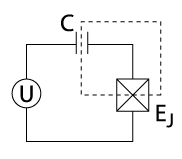
In quantum computing, a charge qubit (also known as Cooper-pair box) is a qubit whose basis states are charge states (i.e. states which represent the presence or absence of excess Cooper pairs in the island).[1][2][3] In superconducting quantum computing, a charge qubit[4] is formed by a tiny superconducting island coupled by a Josephson junction (or practically, superconducting tunnel junction) to a superconducting reservoir (see figure). The state of the qubit is determined by the number of Cooper pairs that have tunneled across the junction. In contrast with the charge state of an atomic or molecular ion, the charge states of such an "island" involve a macroscopic number of conduction electrons of the island. The quantum superposition of charge states can be achieved by tuning the gate voltage U that controls the chemical potential of the island. The charge qubit is typically read-out by electrostatically coupling the island to an extremely sensitive electrometer such as the radio-frequency single-electron transistor.
Typical T2 coherence times for a charge qubit are on the order of 1–2 μs.[5] Recent work has shown T2 times approaching 100 μs using a type of charge qubit known as a transmon inside a three-dimensional superconducting cavity.[6][7] Understanding the limits of T2 is an active area of research in the field of superconducting quantum computing.
- ^ Bouchiat, V.; Vion, D.; Joyez, P.; Esteve, D.; Devoret, M. H. (1998). "Quantum Coherence with a Single Cooper Pair". Physica Scripta. T76 (1). IOP Publishing: 165-170. Bibcode:1998PhST...76..165B. doi:10.1238/physica.topical.076a00165. ISSN 0031-8949. S2CID 250887469.
- ^ Nakamura, Y.; Pashkin, Yu. A.; Tsai, J. S. (1999). "Coherent control of macroscopic quantum states in a single-Cooper-pair box". Nature. 398 (6730). Springer Science and Business Media LLC: 786–788. arXiv:cond-mat/9904003. Bibcode:1999Natur.398..786N. doi:10.1038/19718. ISSN 0028-0836. S2CID 4392755.
- ^ Lehnert, K. W.; Bladh, K.; Spietz, L. F.; Gunnarsson, D.; Schuster, D. I.; et al. (2003-01-17). "Measurement of the Excited-State Lifetime of a Microelectronic Circuit". Physical Review Letters. 90 (2). American Physical Society (APS): 027002. Bibcode:2003PhRvL..90b7002L. doi:10.1103/physrevlett.90.027002. ISSN 0031-9007. PMID 12570573.
- ^ Makhlin, Yuriy; Schoen, Gerd; Shnirman, Alexander (2001-05-08). "Quantum state engineering with Josephson-junction devices". Reviews of Modern Physics. 73 (2): 357–400. arXiv:cond-mat/0011269. Bibcode:2001RvMP...73..357M. doi:10.1103/RevModPhys.73.357. ISSN 0034-6861. S2CID 6687697.
- ^ Houck, A. A.; Koch, Jens; Devoret, M. H.; Girvin, S. M.; Schoelkopf, R. J. (2009-02-11). "Life after charge noise: recent results with transmon qubits". Quantum Information Processing. 8 (2–3): 105–115. arXiv:0812.1865. Bibcode:2009QuIP....8..105H. doi:10.1007/s11128-009-0100-6. ISSN 1570-0755. S2CID 27305073.
- ^ Paik, Hanhee; Schuster, D. I.; Bishop, Lev S.; Kirchmair, G.; Catelani, G.; Sears, A. P.; Johnson, B. R.; Reagor, M. J.; Frunzio, L.; Glazman, L. I.; Girvin, S. M.; Devoret, M. H.; Schoelkopf, R. J. (2011-12-05). "Observation of High Coherence in Josephson Junction Qubits Measured in a Three-Dimensional Circuit QED Architecture". Physical Review Letters. 107 (24): 240501. arXiv:1105.4652. Bibcode:2011PhRvL.107x0501P. doi:10.1103/physrevlett.107.240501. ISSN 0031-9007. PMID 22242979. S2CID 19296685.
- ^ C. Rigetti et al., "Superconducting qubit in waveguide cavity with coherence time approaching 0.1 ms," arXiv:1202.5533 (2012)